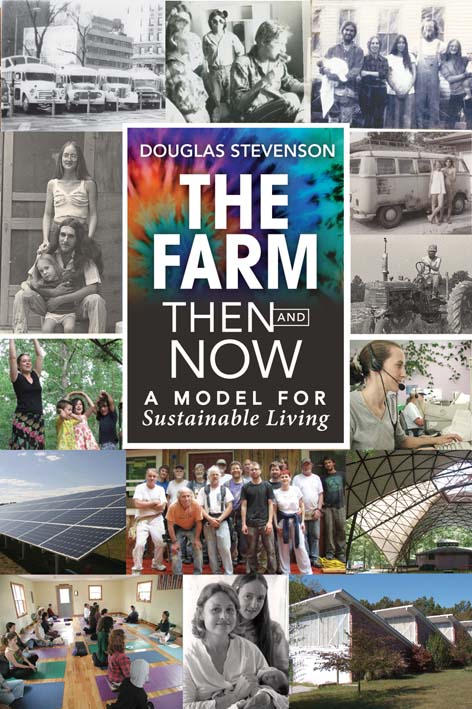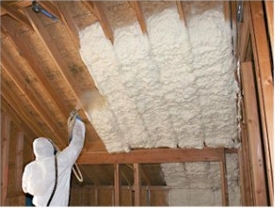
Excerpt from The Farm Then and Now Green Building
A common concern is the importance of energy efficiency, generally regarded as a reduction in power, particularly as it relates to healing and cooling costs. One of the primary ways to accomplish this is through insulation. The type of insulation used in Farm homes has a direct correlation to the timeline and progression of technological advances and their availability in the marketplace.
Insulation is rated by its R-Value per inch of material, representing the resistance to heat flow, keeping heat out in summer and holding onto it in winter. A 6-inch wall would have a 50 percent higher R rating than a 4-inch wall of the same substance. Following that logic, it would take twice as much of material rated at R-3 to achieve the same level of insulation as it would for a material rated at R-6. These numbers are important when designing a home in order to estimate its energy efficiency.

Spray foam insulation expands when applied, producing an air-tight seal.
For many decades, the only commercially available insulation was fiberglass, having a value of R-3.6 to R-5. Fiberglass is manufactured from sand and 20 to 30 percent recycled glass that is combined and spun into a light and fluffy material resembling cotton candy. The sand is normally acquired through mining, and the fiberglass manufacturing process includes toxic chemicals such as formaldehyde.
The spun fiberglass is often attached to a paper or foil batt that can be stapled to wall studs for easy installation, simultaneously creating an air and vapor seal. Holes cut to provide access to electrical boxes and light fixtures break that seal and can be a source of cold air flow or drafts. Fiberglass is also the least expensive option, and it is still widely used in standard construction.
Insulation made from cotton scraps, such as the leftover material from the production of blue jeans, was one of the first readily available type of green insulation. It consists of 80 percent recycled material and does not contain formaldehyde. Acquisition of the raw
material (farming cotton and recycling) has less impact on the environment than mining. The R-value is roughly equivalent to fiberglass, but installation and overall costs are frequently a bit higher. It is sold in rolls and stapled into walls like fiberglass or blown 6 to 8 inches deep into attics and ceilings.
Blown cellulose made from 80 percent recycled newspapers is another commonly available green insulation that carries a value of R-3 to R-4. Cellulose has lost favor because it has been found to settle as much as 20 percent over time, reducing its insulation qualities. Both cotton and cellulose insulations are treated with chemicals as a fire retardant.
Spray foam is a liquid that expands on contact, filling all crevices or gaps producing a perfect, tight seal, blocking any intrusion by outside air. Unlike blown cellulose, it adheres to any surface, allowing it to be used between rafters, floor and ceiling joists or against lightweight skirting enclosing a pier foundation. It has a value of R-3 to R-7, as good or better than any other insulation. The foam also adds to structural stability, functions as a sound barrier and works better than plastic as a vapor barrier.
The downside? Spray foams have been petrochemical based, but formulas based on soy oils and others are being developed from recycled sources. The HFC (hydrofluorocarbon) and HCFC (hydrochlorofluorocarbon) compounds used as propellants to spray the foam are greenhouse gases. Foam also releases toxic fumes if burned, such as in a house fire. Hopefully both of these drawbacks will also change as newer methods and formulas are developed. Because of its excellent R values and ability to seal any and all intrusion from hot or cold air, spray foam insulation has been the choice in many newly constructed homes on The Farm.



